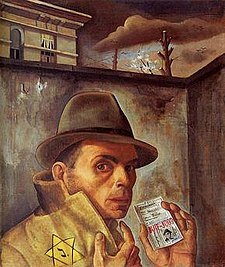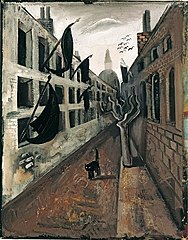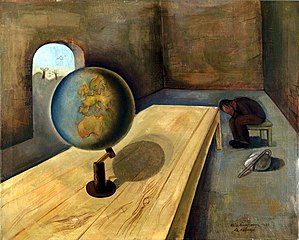Felix Nussbaum
This article has multiple issues. Please help improve it or discuss these issues on the talk page. (Learn how and when to remove these messages)
|
Felix Nussbaum | |
|---|---|
 Self Portrait with Jewish Identity Card (1943) | |
| Born | 11 December 1904 |
| Died | 9 August 1944 (aged 39) |
| Nationality | German |
| Known for | Painting |
| Movement | New Objectivity |
| Spouse | Felka Platek |
| Website | www |

Felix Nussbaum (11 December 1904 – 9 August 1944) was a German-Jewish surrealist painter. Nussbaum's paintings, including Self Portrait with Jewish Identity Card (1943) and Triumph of Death (1944), explore his experiences as a Jew during the Holocaust. His work is usually associated with the New Objectivity movement, and was influenced by the works of Giorgio de Chirico, Henri Rousseau, and Vincent van Gogh. He took refuge in Belgium after the Nazi rise to power, but was deported to Auschwitz along with his wife Felka Platek only a few months before the British liberation of Brussels on 3 September 1944.
Early life and education
[edit]Nussbaum was born in Osnabrück, Germany, to parents Rahel and Philipp Nussbaum. His father was a World War I veteran and German patriot before the rise of the Nazis. He was an amateur painter in his youth, but financial difficulties forced him to pursue more traditional work. This experience is said to have influenced him to encourage his son to pursue art as a profession.
Nussbaum was a lifelong student, beginning his formal studies in 1920 in Hamburg and Berlin, and continuing as long as the tempestuous political situation allowed him. In his earlier works, Nussbaum was heavily influenced by Vincent van Gogh and Henri Rousseau, later taking influence from Giorgio de Chirico and Carlo Carrà as well. Nussbaum's careful approach to color may have been influenced by expressionist Karl Hofer.
In 1933, Nussbaum was studying under a scholarship in Rome at the Berlin Academy of the Arts when the Nazis seized control of Germany. When Adolf Hitler sent his Minister of Propaganda to Rome in April to disseminate Nazi artistic values, particularly the celebration of the Aryan race, Nussbaum realized that, as a Jew, he could not remain at the academy.
Deportation to death camps
[edit]
The next decade of Nussbaum's life was characterized by fear, which is reflected in his artwork. While studying in Berlin, Nussbaum met painter Felka Platek; they would later marry in Brussels during their shared exile. In 1934, he took Platek to meet his parents in Switzerland. Felix's parents eventually grew homesick for Germany and, against his fierce objections,[1] they returned. This was the last time Felix would see his mother and father — the source of his spiritual and financial support. Felix and Felka would spend the next ten years in exile, mostly in Belgium, a period of emotional and artistic isolation for him but also one of the most artistically productive times in his life.[2]
After Nazi Germany attacked Belgium in 1940, Nussbaum was arrested by Belgian police as a "hostile alien" German, and was subsequently taken to the Saint-Cyprien camp in France. The desperate circumstances in the camp influenced his work during this time. He eventually signed a request to the French camp authorities to be returned to Germany. On the train ride from Saint-Cyprien to Germany, he managed to escape and settled with Felka in occupied Belgium, and they began a life in hiding.[3] Without residency papers, Nussbaum had no way of earning an income, but friends provided him with shelter and art supplies so that he could continue his craft. In 1943 he painted The Self Portrait with a Jewish identity card.[3] In the painting there is a tree (Nussbaum translates into Nuttree in English) whose branches are cut, with one branch bearing blossoms.[3]
In 1944, the Nussbaum family was greatly impacted by the plans of Nazi Germany; Philipp and Rahel Nussbaum were murdered at Auschwitz in February, and in July Nussbaum and his wife were found hiding in an attic by German armed forces. They were arrested, sent to the Mechelen transit camp and given the numbers XXVI/284 and XXVI/285. On 2 August, they arrived at Auschwitz, and a week later, Felix was murdered at the age of 39. On 3 September, Nussbaum's brother was sent to Auschwitz, and on 6 September his sister-in-law and niece were also murdered there. In December, his brother – the last of the family – died from exhaustion in the camp at Stutthof. Within one year, the entire Nussbaum family had been murdered.
Major works
[edit]In this time period, Nussbaum created two of his best-known works: Self Portrait with Jewish Identity Card (1943), and Triumph of Death (1944).
Triumph of Death
[edit]Triumph of Death shows Nussbaum's attention to detail. According to his biography, Felix Nussbaum: Art Defamed; Art in Exile; Art in Resistance, the crumpled music score has the first several bars of "The Lambeth Walk", a popular song from the musical Me and My Girl. The words that would normally accompany the music are "Ev'rythin' free and easy / Do as you darn well pleasey".
Selected paintings
[edit]-
Remembering Grüßau
-
Fairground
-
The Secret
-
Puppets
-
Self-portrait with Towel
-
The Desolate Street
-
The Triumph of Death
-
The Refugee
Legacy
[edit]
Felix Nussbaum's artwork reflects and interprets his experiences as a victim of the Holocaust. In 1998, the Felix Nussbaum Haus in Osnabrück opened to permanently exhibit his works.[4]
He was featured alongside fellow concentration camp survivors and artists Jan Komski and Dinah Gottliebova in the 1999 documentary film Eyewitness, which was nominated for an Academy Award for Documentary Short Subject.[5][6]
Art and Remembrance: The Legacy of Felix Nussbaum is a 1993 documentary directed by Barbara Pfeffer.[7]
References
[edit]- Citations
- ^ Felix Nussbaum at www1.yadvashem.org
- ^ "Arts in Exile". German National Library. Retrieved 31 January 2014.
- ^ a b c Steinkamp, Maike (2005). Pfisterer, Ulrich; von Rosen, Valeska (eds.). Der Künstler als Kunstwerk: Selbstporträts vom Mittelalter bis zur Gegenwart (in German). P. Reclam. p. 164. ISBN 978-3-15-010571-9.
- ^ Irvy, Benjamin (24 August 2010). "Frum Amid the Horror". The Forward. Retrieved 13 June 2024.
- ^ "NY Times: Eyewitness". Movies & TV Dept. The New York Times. 2012. Archived from the original on 16 October 2012. Retrieved 6 December 2008.
- ^ "Eyewitness". Seventh Art Releasing. Retrieved 7 March 2012.
- ^ "Barbara Pfeffer Photojournalist, 65". The New York Times. 9 March 1999. Retrieved 13 June 2024.
- Bibliography
- "Friedensstadt Osnabrück - Felix Nussbaum" Archived 2008-02-09 at the Wayback Machine
- Karl, Kaster G. Felix Nussbaum: Art Defamed, Art in Exile, Art in Resistance. 1st English ed. Overlook, 1997.
- "Ten Dreams: Felix Nussbaum Galleries"
- Berger, Eva (2007). Felix Nussbaum : verfemte Kunst - Exilkunst - Widerstandskunst (in German) (4 ed.). Bramsche: Rasch. ISBN 978-3-89946-089-6.
External links
[edit]- Felix Nussbaum - online exhibition from Yad Vashem
- Werkverzeichnis Archived 19 July 2011 at the Wayback Machine
- Ten Dreams Galleries
- The Felix Nussbaum Haus (Museum)
- 1904 births
- 1944 deaths
- Artists from Osnabrück
- 20th-century German painters
- 20th-century German male artists
- German male painters
- German surrealist artists
- Jewish painters
- German people who died in Auschwitz concentration camp
- German civilians killed in World War II
- The Holocaust in Belgium
- German Jews who died in the Holocaust








